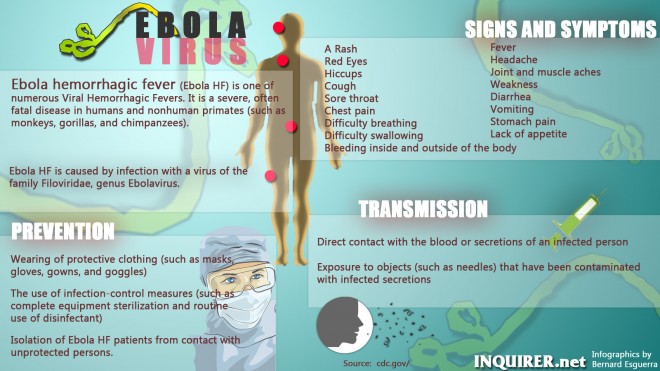Health authorities are closely monitoring the condition of seven of 15 Filipino migrant workers who returned last month from Sierra Leone, in West Africa, where an Ebola outbreak has killed more than 700 people.
Officials said most of the migrants were construction workers repatriated from Sierra Leone on orders of their employers due to the Ebola outbreak, which has also stricken Guinea and Liberia.
The Philippines has 115 peacekeepers in Liberia, but the military said on Friday that the peacekeepers working for the United Nations mission had been reminded to take extra precautions against the Ebola outbreak.
Lyndon See Suy, spokesperson for the Department of Health, told a press briefing on Friday that health authorities have been monitoring the migrant workers since they returned from Sierra Leone in late June.
“They came in batches starting the last week of June until mid-July. Since their arrival, we have been calling them every day to check on them,” Suy said.
Philippines ‘Ebola-free’
He sought to ease fears that the Ebola virus might reach the Philippines, saying the country remains “Ebola-free.”
“The Department of Health is in a better position now to contain this if it reaches us,” Suy said.
He refused to give further information about the migrant workers from Sierra Leone, even their current location, saying the DOH had promised them confidentiality.
“We got their contact numbers through their recruitment agencies. And we have been calling them since,” Suy said.
He said that with help from the Bureau of Quarantine, DOH personnel met all the 15 at the airport upon their arrival, but the follow-up checks were done over the phone.
The health personnel, he said, asked the workers if they were showing any symptoms similar to Ebola.
Three of the 15 exhibited Ebola-like symptoms, which include fever and diarrhea but all of them later tested negative for the disease.
“We called the help of the [DOH] regional office and they were immediately taken to the hospital. Their specimens were taken and brought to the Research Institute for Tropical Medicine for examination,” Suy said.
The three patients along with five other migrants have been cleared of Ebola, Suy said. Only the remaining seven are being monitored, he added.
Suy said it was not necessary for the DOH to check up all of the seven personally, as the close monitoring it had been conducting since their arrival were part of the standard precautions.
He said the workers were being monitored only because they came from an Ebola-stricken country.
The health department also advised all overseas Filipino workers with fever, headache, intense weakness, joint and muscle pains and sore throats to seek clearance from health authorities in their countries of employment before traveling home to the Philippines to prevent the entry of the Ebola virus in the country.
“You don’t want to risk the lives of your families and loved ones,” Suy said, adding that all the 15 migrants who returned from Sierra Leone have been cooperating with the DOH.
In a statement, Health Secretary Enrique Ona said his department was strictly watching the Ebola outbreak and would not allow it to reach the Philippines.
He said an interagency meeting was recently organized by the Office of Migrant Workers of the Department of Foreign Affairs (DFA) to discuss the situation of Filipino workers in the three Ebola-stricken West African countries.
Hans Cacdac, administrator of the Philippine Overseas Employment Administration (POEA), said there were 280 newly hired workers in Sierra Leone. But with crisis alert level 2 raised by the DFA in Sierra Leone, Guinea and Liberia, the POEA had declared a ban on the deployment of new hires.
According to DFA records, 880 Filipinos are working in Guinea; 632, including peacekeepers for the United Nations, are in Liberia, and 1,979 in Sierra Leone.
Peacekeepers safe
Lt. Col. Ramon Zagala, spokesperson for the Armed Forces of the Philippines (AFP), told reporters yesterday that a health advisory was issued to the 115 Filipino peacekeepers in Liberia way back in March.
“This health advisory gives direction for measures to be followed by all personnel stationed in affected areas and adjacent affected areas such as Liberia,” Zagala said.
He said the members of the Philippine peacekeeping contingent led by Col. Glicerio Peralta remained “Ebola-free.”
“We’d like to assure the peacekeepers’ families that all health and safety precautions are being done and led by the UN to ensure that our troops’ safety and health will not be compromised,” Zagala said.
Ona said the Filipino migrant workers in the three West African countries were coordinating with their recruitment agencies to assess the risk to themselves.
“Proper coordination of Philippine labor officials is now being undertaken with the DFA and the Bureau of Immigration for possible repatriation,” Ona said.
The DOH through the quarantine bureau will determine the status of returning Filipino migrant workers upon arrival and refer symptomatic cases to hospitals, he said.
Migrants not showing symptoms will be closely monitored daily by the Heath Emergency Management Staff of the DOH, he said.
Deadly disease
According to the DOH, Ebola is a severe, infectious, often fatal disease in humans and primates (monkeys, gorillas and chimpanzees) caused by infection from the Ebola virus.
Ebola can be transmitted through contact with blood secretions, organs or other bodily fluids of infected animals, body fluids and stool of an infected person, contaminated needles and soiled linen used by infected patients, or direct contact with the body of a patient who died from the disease.
Signs and symptoms of infection with Ebola virus include fever, headache, intense weakness, joint and muscle pains and sore throat.
Ona said earlier that “there is no specific cure or vaccine yet available” for Ebola. With a report from Julie M. Aurelio
RELATED STORIES
PH airports on full alert for Ebola virus
Ebola virus stops new OFW hires
PH has procedures to track, prevent Ebola spread — DOH
